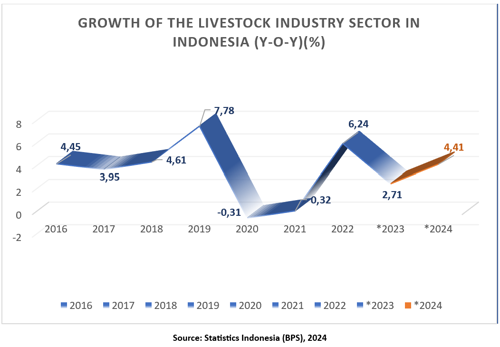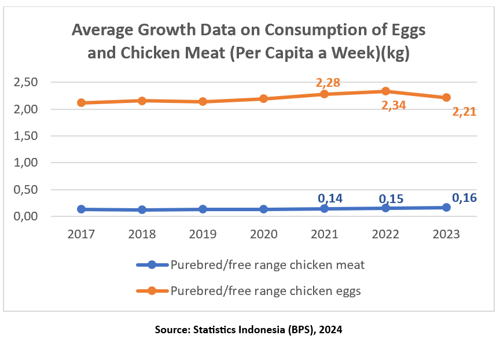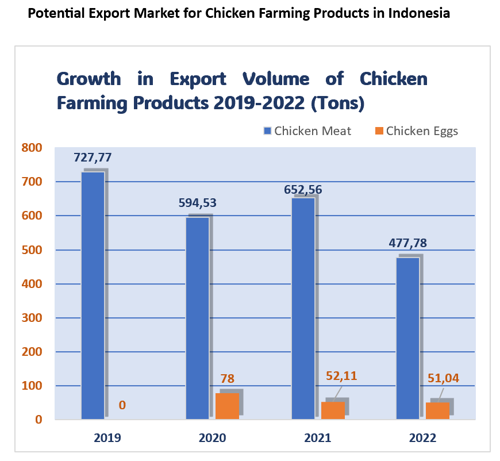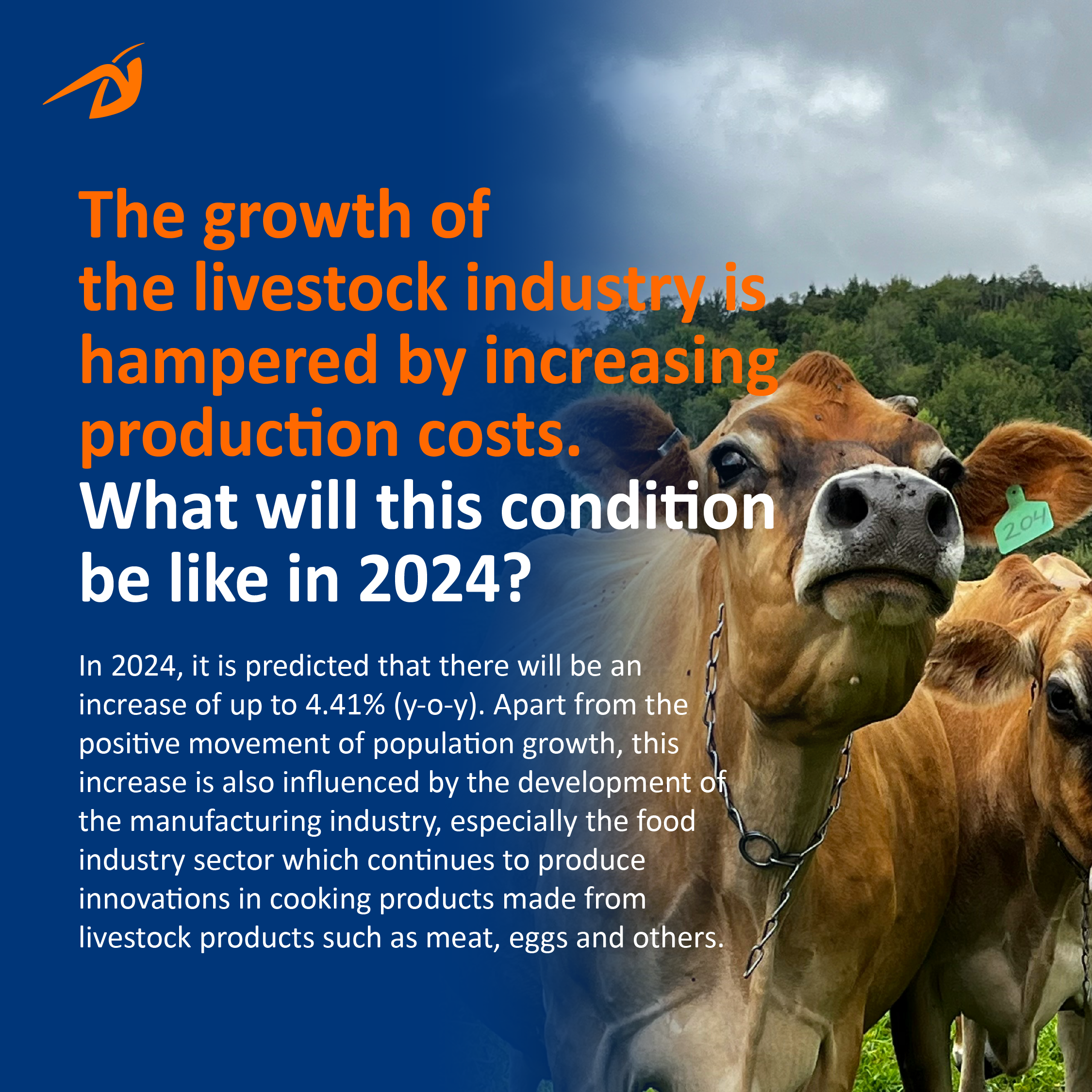Based on GDP growth in the Livestock Sector in 2023, the livestock sector experienced positive growth of around 2.71% (y-o-y). There was a decrease of 3.53 points when compared to 2022 which could reach 6.24% (y-o-y). This is caused by several factors, such as an increase in imports of Grans Parent Stock which causes the supply of DOC (Day Old Chick) to exceed demand, an increase in the price of livestock production facilities which include DOC or chicks, feed, vaccines, vitamins and medicines which causes costs production is increasing, the effect of tightening monetary policy is decreasing consumption expenditure, and the supply chain is long and the poultry industry is not yet ready to carry out downstreaming.

In 2024, it is predicted that there will be an increase of up to 4.41% (y-o-y). Apart from the positive movement of population growth, this increase is also influenced by the development of the manufacturing industry, especially the food industry sector which continues to produce innovations in cooking products made from livestock products such as meat, eggs and others. This is related to the government program in 2024 to develop the national livestock industry. These main activities include increasing national production, namely by providing seeds and livestock, developing livestock, dealing with Strategic Infectious Animal Diseases (PHMS) and other exotics, providing quality feed, and improving product quality. Meanwhile, activities to increase competitiveness are carried out downstream by utilizing surplus frozen eggs, liquid eggs and egg flour. The development of processed products from livestock is through regional development or closed loop livestock companies, developing magot, strengthening facilities and infrastructure, as well as processing and marketing.
The prediction is that in 2024, the world will still be characterized by a global crisis, but with Indonesia's economic growth of 5.15%, the national level is optimistic that it will be safe. This phenomenon will indirectly cause people's preferences for consumption of animal protein foods such as eggs and chicken to increase in the future. The increase in demand for poultry products is based on population growth, which is estimated to reach 318 million in 2045, which will be dominated by urban residents. Apart from that, the economic growth that occurs also indicates an increase in income in society, so that it will influence food preferences that take more health into consideration, namely more from animal sources, vegetables and fruit, with higher quality and safety. For this reason, there must also be growth in food supply at least equal to food demand.
Development of National Chicken Farming Product Consumption
Not only cattle farming, the chicken farming sector also has an important role in several manufacturing industries in Indonesia because it is closely related to primary aspects in society, especially the production and consumption of livestock products in the food industry. Therefore, the government is required to be able to plan policies well so that the potential of the livestock sector can be maximized, not only by meeting community needs but also by increasing product quality.
Despite the role of the chicken farming sector, there are still many Indonesians who do not realize that eggs and chicken meat are a very cheap and high-quality source of protein. Currently, the price of an egg is more or less the same as a cigarette. However, based on data from the Poultry Association, Indonesian people still need to increase egg consumption.

In 2023, the average Indonesian people's consumption of chicken eggs was at 2.21 kg per capita a week. Meanwhile, consumption of chicken meat is 0.16 kg per capita a week. This consumption is still below the world average egg consumption which reaches 10.00 kg per capita in a month or around 2.50 kg per capita in a week. Likewise, Indonesian chicken meat consumption is compared with world chicken meat consumption which reaches 14.90 kg per capita in a year or around 0.31 kg per capita in a week. Even in Malaysia, consumption of chicken meat and eggs reaches twice the consumption in Indonesia.
Adoption of the use of technology and innovation as a key factor in production efficiency is still not optimal, so productivity is still relatively low, when compared to broiler chicken cultivation in several countries with advanced poultry industries such as Brazil, the United States or Thailand. Until now, there is still no digital ecosystem for the poultry industry, so there are still many benefits of information technology that farmers cannot get. This can be seen from the fact that there are still many poultry farms as a business that are not yet bankable. This is because there are no production and business financial records which are the main parameters for lenders in assessing the feasibility of a business to obtain a loan (People's Business Credit).
On the other hand, poultry prices tend to be unstable at certain moments. Final Stock seeds, which are often oversupplied and uncertainty in the price of raw feed materials, have caused the Cost of Production (HPP) to continue to rise, but this has not been balanced by the stability of the selling price of live birds. Even though the government has made efforts to stabilize prices, the policies implemented are only limited to post price fluctuations so optimally controlled preventive measures cannot be taken.
The use of information technology is one of the key solutions in the digital era like now. It is time for information technology to enter the broiler chicken farming industry to help make poultry management more open and competitive. If this can be fully implemented, then breeders will get information technology services as a catalyst for a digital-based poultry governance system that can help breeders' businesses become more bankable. With the existence of a digital ecosystem in poultry, it will give rise to a very large collection of data called Big Data.
Potential Export Market for Chicken Farming Products in Indonesia

Not only the domestic market, the export market for chicken farming products also contributes to the development of the chicken farming sector. Several export destination countries that have been targeted by Indonesian players to date include export destination countries to Singapore, Japan, Papua New Guinea, Timor Leste, Myanmar,
Looking at the development of export activities in 2022, there was a decrease in the volume of chicken meat exports by 26.78% (y-o-y), namely a decrease from 652.56 tons to 477.78 tons per year. In 2023, there are no exact figures yet, but as of May 2023, it was recorded that 255.68 tonnes of chicken meat had been exported to several countries. If calculated proportionally, then by the end of the year the export volume will reach around 613.63 tons or an increase of around 28.43% (y-o-y). Meanwhile, the contribution from the chicken egg export market in Indonesia is still quite small. In 2022, there was a decrease in export volume by 2.05%, namely from 51.04-tons to 52.11-tonnes.
